Meteor Shower October 2017 Where to Look Up
After a disappointing 2016, when most of the annual major meteor showers were washed out by moonlight, 2017 looks far more promising.
Of the big three, the Quadrantids in January and Geminids in December are both visible in dark, moonless skies. Sadly, the Perseids in August will again be badly obscured by a waning gibbous Moon, but they are always worth watching.
Here we detail the predicted meteoric highlights for the coming year for the northern (N) and southern (S) hemispheres, and those visible for both (N/S).
New this year, for each shower we also give the maximum Zenithal Hourly Rate (ZHR): the maximum number of meteors per hour that could be seen, given absolutely ideal conditions.
The rates you actually observe will be lower than this value. The higher a shower's radiant in the sky, and the darker the conditions, the closer the observed rates will get to the ZHR.
For this reason, if you want to see the best of a meteor shower, try to find a good, dark site (far from streetlights), and give your eyes at least half an hour to adjust to the darkness.
For each shower, the time of forecast maximum is given in Universal Time (UT), with conversions to local time for certain regions where the shower could be observed. For other regions simply convert from UT into your local timezone.
The parent is the comet or asteroid responsible for the debris through which the Earth passes each year that's the cause of the annual meteor shower.
Quadrantids (N)
Active: December 28, 2016 - January 12, 2017
Forecast Maximum: January 3, 2pm UT = January 3, 6am PST (West Coast, US) = January 3, 11pm JST (Japan)
ZHR: ~120
Parent: Comet 96P/Machholz / Asteroid 2003 EH1
The Quadrantids get the new year off to a meteoric start. At their peak they can be spectacular, with rates often exceeding 100 meteors per hour.
For locations north of 40 degrees north, the shower's radiant (the point on the sky from which the meteors appear) is circumpolar, which means it is always above the horizon.
The result? Quadrantid meteors can be seen throughout the hours of darkness. The best viewing is after midnight, local time, as the radiant climbs high into the morning sky.

For most of the shower's fortnight of activity, only one or two meteors per hour might be seen. For that reason, the Quadrantids are often overlooked, but at their best, they are well worth the effort of setting an early morning alarm on a cold winter's night.
The forecast maximum this year favours locations in the western part of North America and in far East Asia. Observers north of the Arctic Circle have the privilege of being able to watch the shower continuously, if they can brave the winter cold.
Lyrids [N/S]
Active: April, 16-25
Forecast Maximum: April 22, 12pm UT = April 22, 5am PDT (West Coast, US) = April 22, 10pm AEST (QLD/NSW/ACT/Vic/Tas) = April 22, 8pm AWST (WA)
ZHR: 18
Parent: Comet C/1861 G1, Thatcher
The Lyrids are a fairly consistent, moderately active meteor shower, producing around 15 to 20 meteors per hour at their peak.
Visible from either hemisphere, the Lyrids are best observed from northern latitudes, where the radiant climbs high in the sky before dawn. This year, the forecast peak favours observers in the Americas, although the precise timing of the maximum has been known to vary somewhat from year to year.

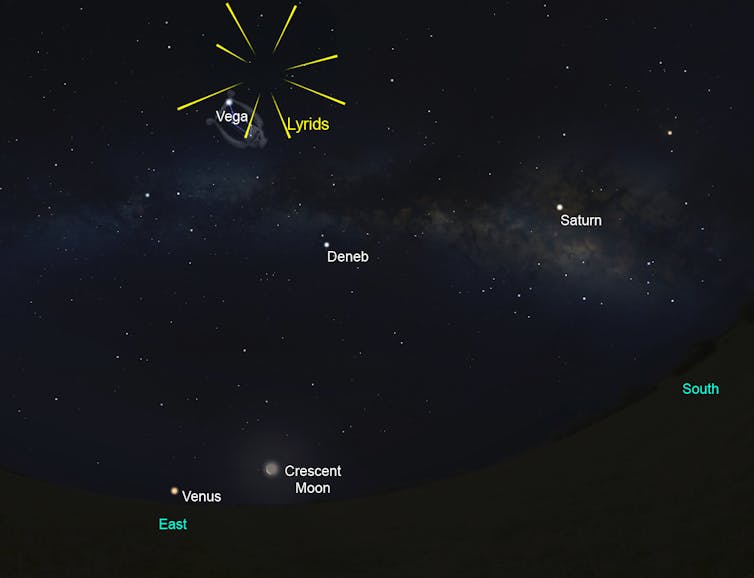
The Lyrids have the longest recorded history of any meteor shower, with observations dating back to at least 687BC.
While the Lyrids are typically only a moderately active shower, they can occasionally be truly spectacular. Every 60 years or so, they produce rates much higher than normal, an event known as an outburst.
The most recent such event occurred in 1982 when, for a short time, rates topped 90 meteors per hour. In 1803 the shower was more spectacular still. Rates reached storm proportions, and the sky over the eastern states of the US was alight with meteors, rates of more than 700 per hour.
This year, unfortunately, no such enhanced activity is forecast. Nevertheless, the Lyrids are still worth a look, letting us see pieces of a comet that currently lies more than a hundred billion kilometres distant.
Eta Aquariids [S]
Active: April 19 - May 28
Forecast Maximum: May 6, 2am UT = May 6, 12pm AEST (QLD/NSW/ACT/Vic/Tas) = May 6, 10am AWST (WA)
ZHR: 50
Parent: Comet 1P/Halley
For observers in the southern hemisphere, the Eta Aquariids are one of the highlights of the meteor calendar.
Active in autumn, as the nights grow ever longer, the Eta Aquariids are best observed in the hours before dawn, when rates can climb as high as 40 or 50 meteors per hour.
Even for locations well south of the equator, the radiant does not rise until 1am or later, so this is definitely one to set the alarm for.
The Eta Aquariids are the stronger of two annual showers produced when Earth passes through debris shed by Comet 1P/Halley. We'll come to its sister shower, the Orionids, later.
The debris shed by Comet Halley is spread in a wide band across Earth's orbit, which results in the Eta Aquariids being active for a period of around six weeks. Peak rates occur for just a week or so around the forecast maximum.
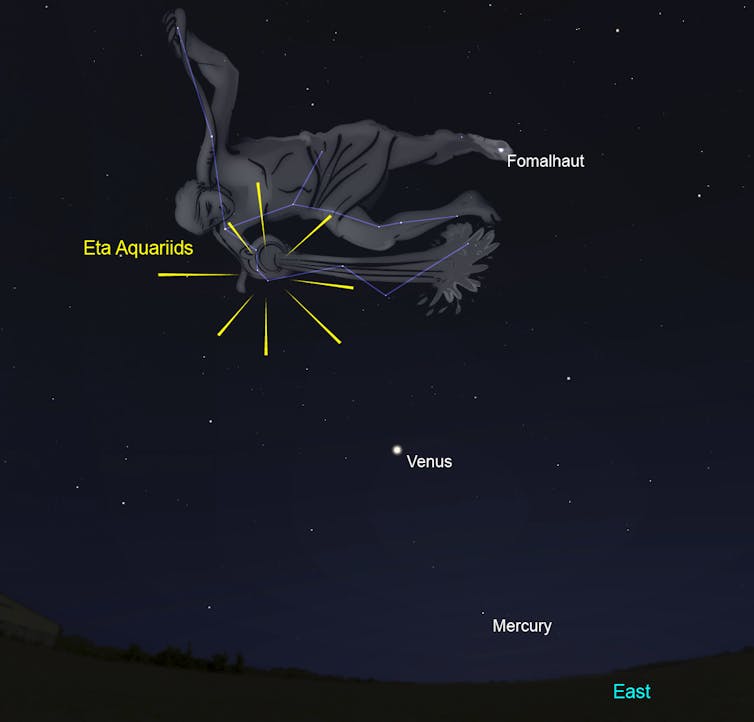
Observers who brave the pre-dawn hours to observe the shower this year are in for an added treat, with Venus and Mercury putting on a spectacular show as the dawn twilight builds.
The Eta Aquariids themselves are fast meteors, and are often bright, continuing to make an impression as the sky brightens before dawn.
The Southern Delta Aquariids, Piscis Austrinids and Alpha Capricornids [N/S; S favoured]
Active: Early-July to Mid-August
Forecast Maxima: July 28-30
Combined ZHR: 35
Parent: Comet 96P/Machholz (Southern Delta Aquariids); Unknown (Piscis Austrinids); Comet 169P/NEAT (Alpha Capricornids
During late July and early August, three meteor showers combine to provide a nice spectacle for keen observers, particularly those in the southern hemisphere.
Given that the normally reliable and spectacular Perseids (mid August) are badly affected by moonlight this year, these showers allow observers to get their mid-year meteor fix.
These three showers, combined, favour observers in the southern hemisphere, though they can also be observed from northern latitudes. From both hemispheres the rates get better as the night goes on and the radiants rise, with the best rates seen in the hours after midnight.
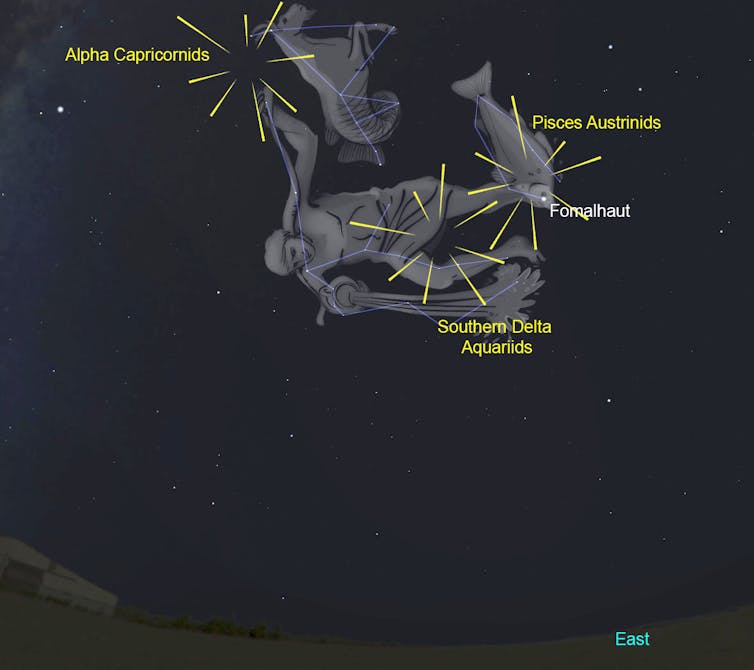
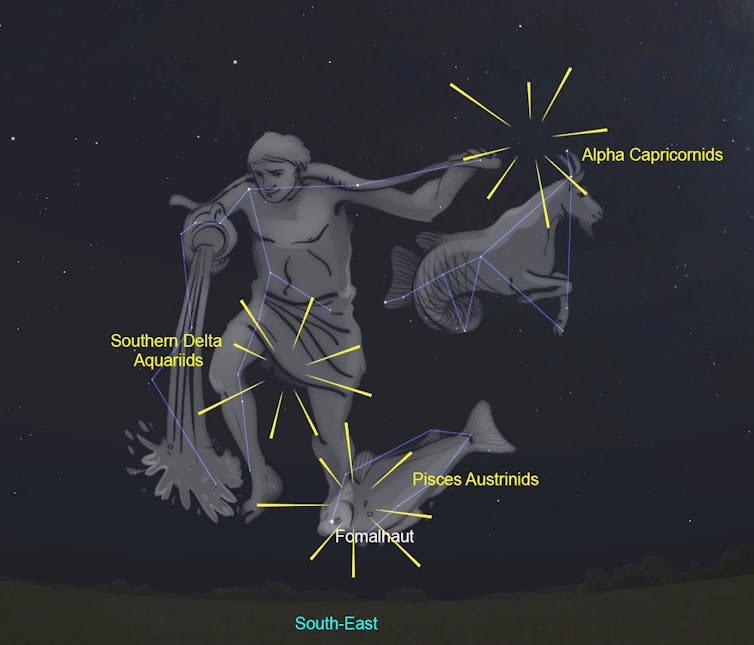
Of the three, the Southern Delta Aquariids are the most active, with a broad peak lasting around five days, centred on July 30. Their meteors are the fastest of the three showers, as well as the most numerous.
The Alpha Capricornids, by contrast, are relatively slow and infrequent (just five or so per hour), but are often spectacular, with a reputation as a fireball shower. When combined with the activity from the other two showers, they represent a great opportunity for budding astro-photographers to get some spectacular shots.
Orionids [N/S]
Active: October 2 - November 7
Forecast Maximum: October 21
ZHR: 20
Parent: Comet 1P/Halley
The Orionids are the second of the annual meteor showers associated with the most famous comet, 1P/Halley.
In October, the Earth passes slightly farther from the densest part of Halley's debris stream than in May, so the Orionids are somewhat weaker than their sister shower.
This is more than offset by the ease with which they may be observed. The Orionid radiant reaches a reasonable altitude by around midnight, local time. As a result, the shower can yield good rates for several hours before the sky starts to brighten before dawn.

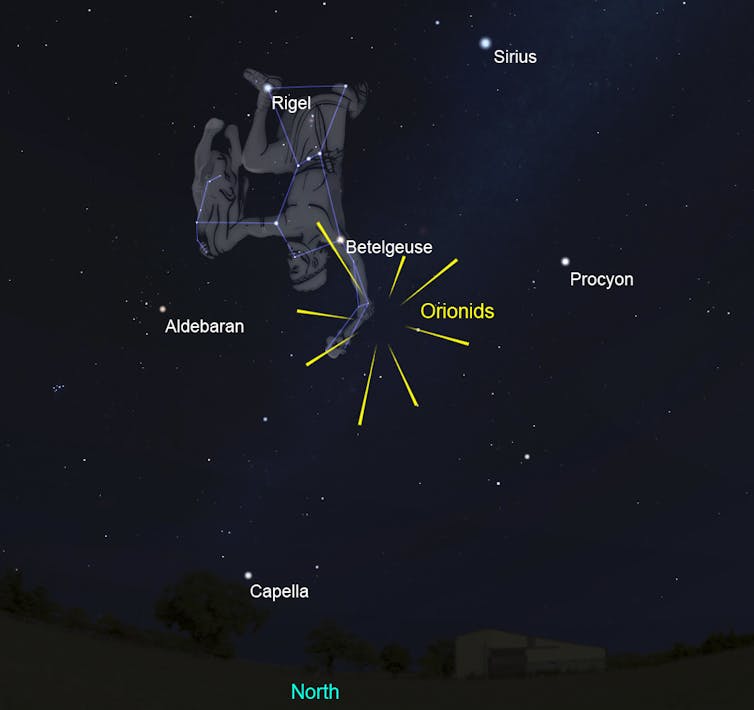
Though peak rates are forecast to occur on October 21, the Orionid maximum is usually a broad and prolonged affair. Good rates can be seen for several days before and after the maximum, with several sub-maxima occurring as Earth passes through denser filaments of debris in the broader stream.
Orionid rates are supplemented by meteors from the Taurid stream, a minor shower active from September until December. Where the Orionids are fast, the Taurids are very slow but they often produce spectacular fireballs.
Geminids [N/S]
Active: December December 4-17
Forecast Maximum: December 14, 6:30am UT = December 14, 1:30am EST (East Coast, US) = December 14, 5:30pm AEDT (NSW/ACT/Vic/Tas) = December 14, 4:30pm AEST (QLD) = December 14, 2:30pm AWST (WA)
ZHR: 120
Parent: Asteroid 3200 Phaethon
The Geminids are probably the most reliable and rewarding of the annual meteor showers. Visible from either hemisphere, they yield peak rates of well over a hundred meteors per hour.
Unlike some other showers, those peak rates persist for several hours (up to a day) so observers across the globe have the chance to see the shower at its best.
From locations well north of the equator the radiant rises just after sunset and good rates can be seen from the mid-evening onwards.
For the southern hemisphere the radiant rises later (mid-to-late evening). As the radiant climbs, so too will the number of meteors that can be seen.

Geminids are moderately fast meteors, and are often bright. They also seem to persist slightly longer in the sky than meteors from other showers.
For southern observers, they are a fantastic summer treat to end the meteoric year, but for those north of the equator, one shower remains that can occasionally throw up an unexpected festive treat.
Ursids [N only]
Active: December 17-26
Forecast Maximum: December 22, 3pm UT = December 22, 7am PST (West Coast, US) = December 22, 11pm JST (Japan)
ZHR: 10, variable
Parent: Comet 8P/Tuttle
The Ursids are the final shower of the year, and are only visible for locations in the northern hemisphere.
Ursid meteors radiate from within just 14 degrees of the north celestial pole, so the radiant only changes in altitude by 28 degrees over the course of a night!
In most years, the Ursids are a fairly minor shower, yielding only ten meteors per hour at their peak for dedicated observers. But in the past they have produced at least two major outbursts, and the maximum activity seems to vary somewhat from year to year.
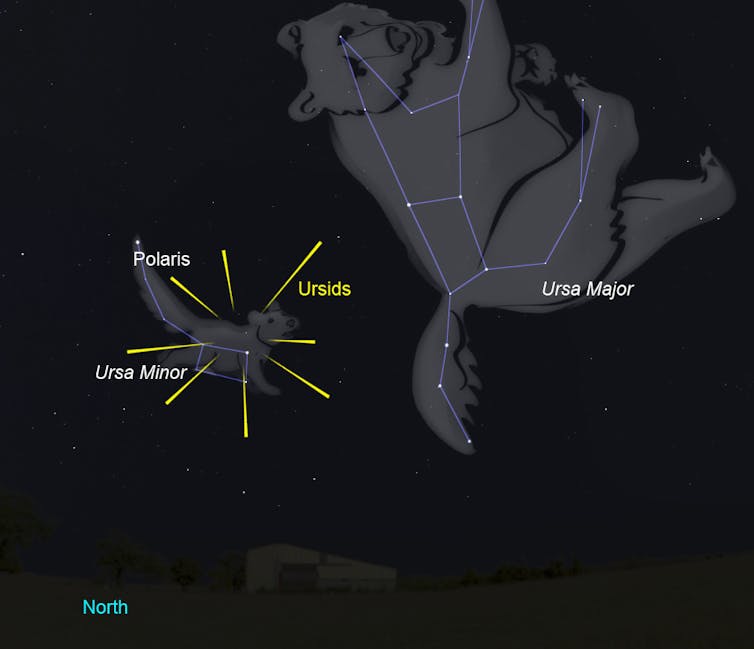
No major outburst is forecast for this year, but the Ursids are a shower of surprises.
There is the possibility that the Earth will encounter a denser clump of debris around 15 minutes ahead of the time of forecast maximum. That debris, left behind by the shower's parent comet, 8P/Tuttle, in 884AD, will likely have become quite dispersed in the 1,133 years since it was lain down. As a result, any increase to the observed rates will probably be relatively small.
But it could still be well worth a look, just in case the Ursids manage to surprise us once again.
Meteor Shower October 2017 Where to Look Up
Source: https://theconversation.com/look-up-your-guide-to-some-of-the-best-meteor-showers-for-2017-64885
0 Response to "Meteor Shower October 2017 Where to Look Up"
Post a Comment